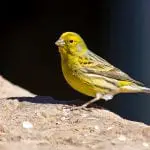Scientific Facts
| Common Name | Cuban Amazon |
| Scientific Name | Amazona leucocephala |
| Lifespan | 50 – 60 Years |
| Size | 12.5 inches (32cm) |
| Body Mass | 8.4 – 9.1oz. (240 – 262grams) |
| Habitat | Palm groves, mangroves, woodland, pine forest, cultivated areas |
| Range | The Cayman Islands, the Bahamas, Cuba |
Information & Physical Appearance
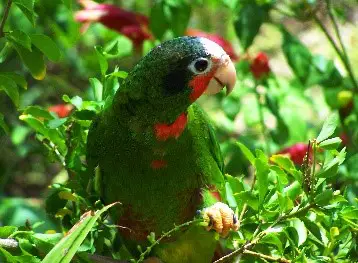
The Cuban Amazon is scientifically referred to as Amazona leucocephala.
Amazona leucocephala is a member of the order Psittaciformes, the family Psittacidae, the genus Amazona.
Other common names include Cuban Parrot and Rose-throated Amazon/Parrot.
There are four traditionally recognized subspecies of the Cuban Amazon.
1. A.l. leucocephala – Cuban Amazon/Parrot (nominate race).
This species is sexually monomorphic, meaning that there are no visible differences in the physical appearance of adult males and females.
The plumage is mainly green. There is black scalloping to the feathers. Also, there are some blue feathers in the wings.
The forecrown, the forehead, as well as the area that surrounds the eyes, displays white coloration.
The coloring of the throat, cheeks, and lores is pink/red or rosy pink. There are maroon-colored patches on the abdominal zone.
The ear coverts are colored in dull black. The tail is colored in green, with red coloring at the very base.
The iris is pale olive in color, and there is a white eye ring. The bill is horn-colored.
The legs are pink.
2. A.l. bahamensis – Bahaman Amazon/Parrot
Bahamensis adults are larger in size than adults in the nominate race.
However, adults of both races are quite similar in external appearance, with the major difference that in bahamensis, the abdominal patch is either very small or absent.
Also, the white coloring on the crown extends further and reaches the upper cheeks, and the zone from the eyes to the lores.
Another difference is that there is less red at the very base of the tail in bahamensis adults.
3. A.l. palmarum
Both adultsare darker green in color. In addition to that, the red to the throat is deeper, and the abdominal patch is more extensive than in adults of the nominate race.
4. A.l. caymanensis – Grand Cayman Amazon/Parrot
In both adults, there is more yellow/green coloring. Also, the terminal black rim that edges the feathers is less evident.
The white coloring on the head is limited only to the forehead area. Another difference is that caymanensis adults’ rump and breast are tinged with blue.
Similarly to palmarum adults, the abdominal patch of caymanensis adults is less extensive as compared with adults in the nominate race.
Grand Cayman Parrots are generally larger in size, and there is green coloring on both sides of the neck that separates the red coloring of the throat from the cheek zone.
5. A.l. hesterna
Adults of both sexes display more yellow/green coloring than adults in the nominate race.
In general, hesterna adults are smaller in size.
The maroon-colored abdominal patch is more evident, and the coloring on the throat and cheeks zone is more saturated, deeper.
Juvenile
Juvenile Cuban amazons closely resemble adults. One major difference is that in immature Cuban parrots, there are fewer black edges to the body feathers.
Another significant difference is that there is less maroon coloring on the belly, and the forecrown’s white coloration is washed with yellow.
Lifespan

The longevity of the Cuban Amazon is estimated at up to 60 years of age.
Ecosystem & Habitat
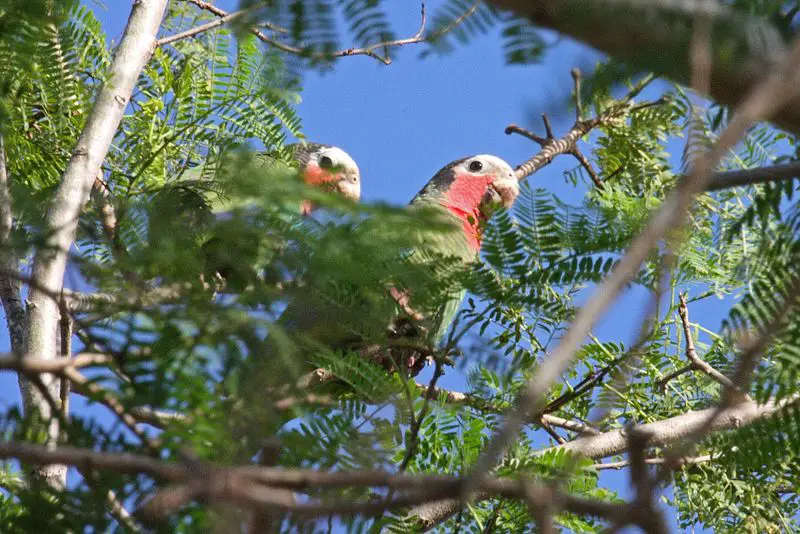
Years ago, the Cuban amazon used to be found all throughout Cuba. Nowadays, its range is confined to the main island of Cuba and Isla de la Juventud.
Range
A.l. leucocephala occurs in central and eastern Cuba.
A.l. palmarum can be found in western Cuba and Isla de la Juventud, reaching to Villa Clara province in the east.
A.l. caymanensis’ range spans across the Grand Cayman Island.
A.l. hesterna is found in Cayman Brac. Back in time, it was also found in Little Cayman Islands.
A.l. bahamensis is a resident of Abaco and Great Inagua (Bahamas Islands). Back in time, it was widely distributed on other islands in the Bahamas, too.
Habitat
Cuban amazons are known to thrive in a variety of habitats. These parrots can be rarely (if ever) found at elevations of over 3280ft. (1000 meters).
Their preferred type of habitat includes broadleaved woodlands, mangroves, pine forest, cultivated land characterized by gardens and trees, as well as plantations and palm groves.
Food & Diet
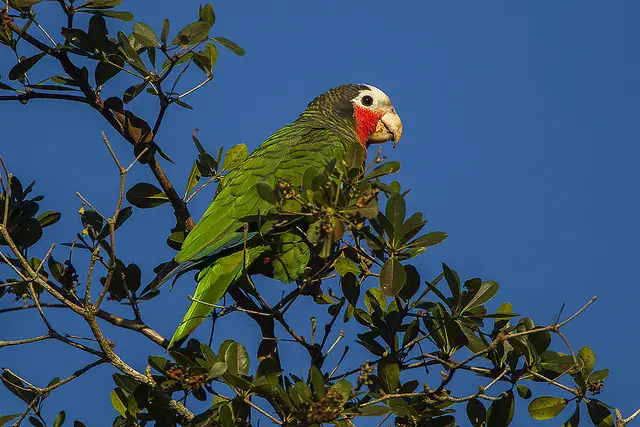
Cuban amazons’s wild diet consists of a number of seeds and fruits.
Palm trees’ fruits are gladly consumed, and so are the seeds obtained from Swietenia mahagoni (West Indian mahogany).
Other favorite types of food in the wild include the unopened leaf buds of Roystonea palms, tender, young shoots, and cones obtained from Pinus caribaea (Caribbean pine), Conocarpus erectus (silver buttonwood), Coccoloba uvifera (sea grape).
Cuban Amazons do also consume a variety of tropical trees and shrubs’ fruits and seeds, especially from plant species in the genus Ernodia, Lysiloma, Metopium, Tabebuia, Swietenia, Sabal, Acacia, Tetrazygia, Cupanis, and Duranta.
Apart from feeding on cones, leaf buds, seeds, fruits, and tender shoots, Cuban parrots do sometimes feed on cultivated crops, too.
Behavior
Cuban amazons do no exhibit migratory behavior.
Instead, they live a relatively sedentary life. Usually, they can be found in pairs or small groups that consist of several parrots. Sometimes they can be found in groups consisting of over 30 birds.
Cuban parrots are especially noisy at times, with their noisiness reaching its peak during flight.
Cuban amazons maintain some form of a family unit, since even when part of flocks, it is most commonly the case that groupings of 2 – 3 birds can be spotted.
What’s more, these smaller groupings within flocks have been observed to feed only with each other, while leaving the rest of the flock’s members. It is towards nightfall when the triplet or pair is to typically reunite with the larger flock.
Cuban amazons roost communally.
Reproduction
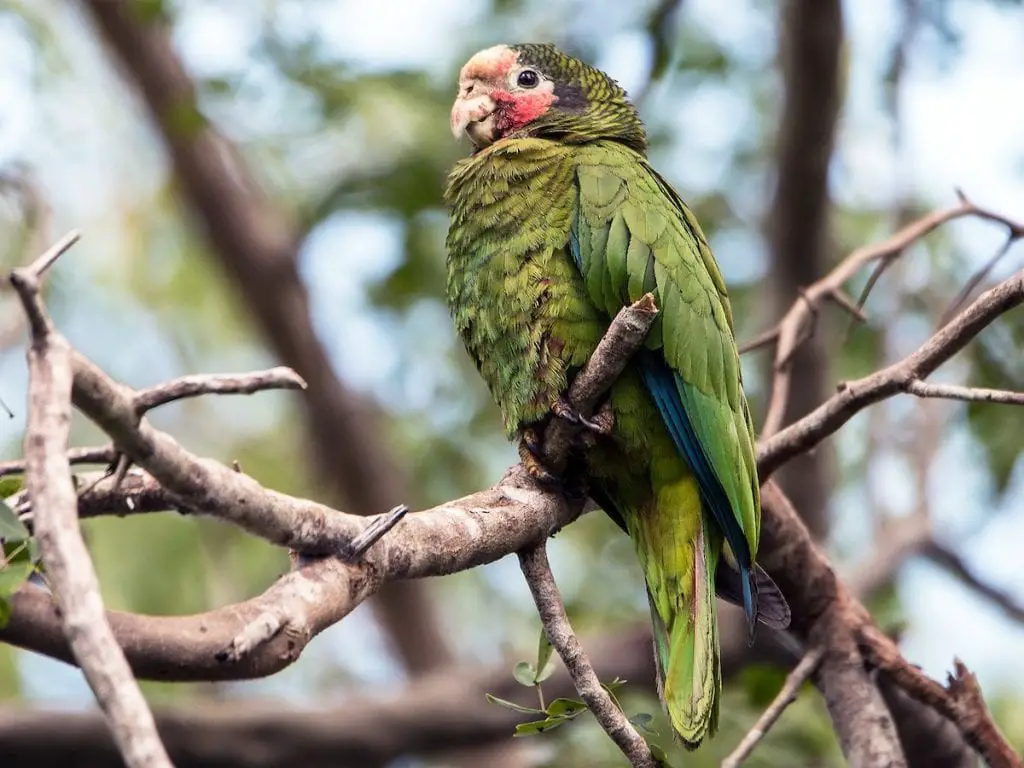
There is no detailed information available when it comes to the reproductive behavior of Cuban parrots.
However, it is known that Cuban amazons are more frequently seen in pairs during the breeding season, or in singles. Outside the breeding season, they are more often seen in groups of up to 30 individuals.
The breeding season starts in March and ends at some point in the middle of the summer season.
Cuban amazons build their nests in hollow tree cavities.
Females are to lay between 2 and up to to 4 eggs. The eggs are white, and almost round in shape.
Incubation takes about 26 – 28 days.
Chicks are born altricial. They are naked, without feathers. Also, their eyes are closed.
It is only after the chicks turn 3 weeks of age when their eyes open.
Parents feed them with regurgitated food.
It is the male to bring food to the female while she is incubating the eggs, as well as for about 7 more days after the chicks hatch.
Later on, the male and the female are to share feeding duties.
The fledging age is estimated at 8 weeks.
Survival Threats & Conservation
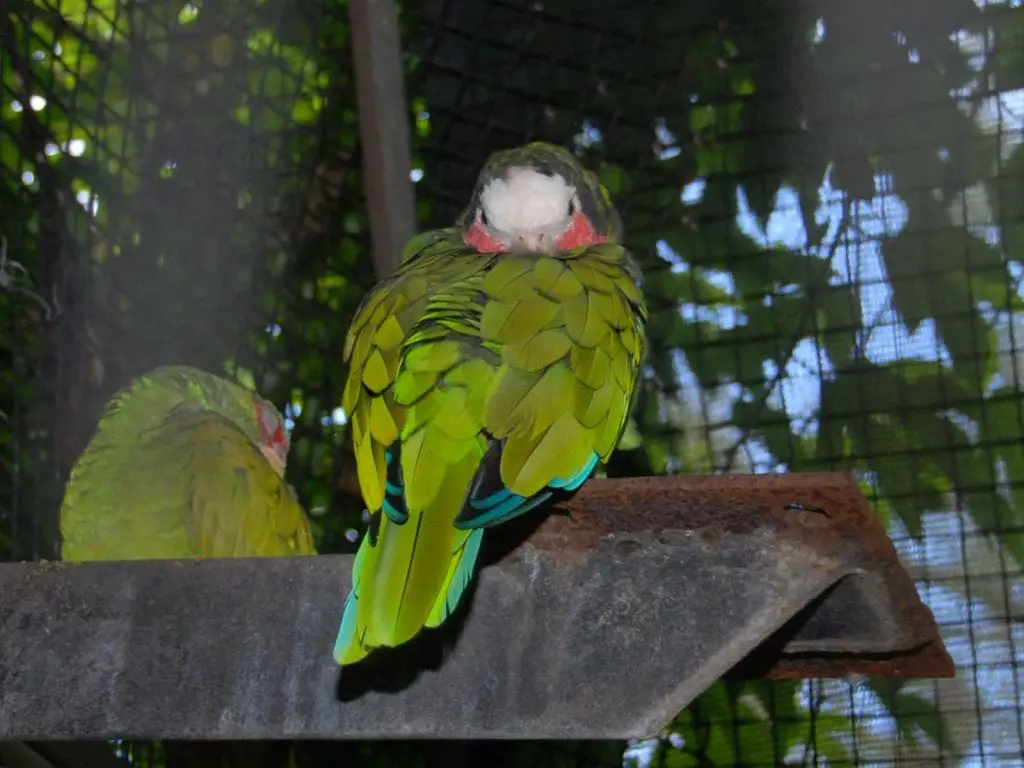
Cuban Amazons are listed on CITES’ Appendix I. Therefore, they are subject to international trade controls.
Cuban parrots are also listed on the IUCN Red List of Threatened Species, and they are given a Near Threatened status.
Based on the data provided by the 2016 global assessment, the world population of Cuban amazons is 13,600-23,000 mature individuals.
Furthermore, the population trend is estimated to decrease.
The major threats for this species’ survival in the future include
1. Severe habitat loss (related to commercial urban development, modern-day housing, residential and urban areas expansion, as well as clearing of land for agriculture and aquaculture purposes).
2. Trapping for the wild bird trade. Note that many young chicks are taken directly from the nest and then sold as pets since knocking down the entire nesting tree is the easiest way to capture these amazing creatures. Tragically, these corrupt practices greatly reduce the number of cavities where these birds can nest in the future.
3. The ongoing consequences of climate change, in particular storms and flooding.
4. Introduced non-native predator species (feral cats).
Availability – Where to Get a Cuban Amazon
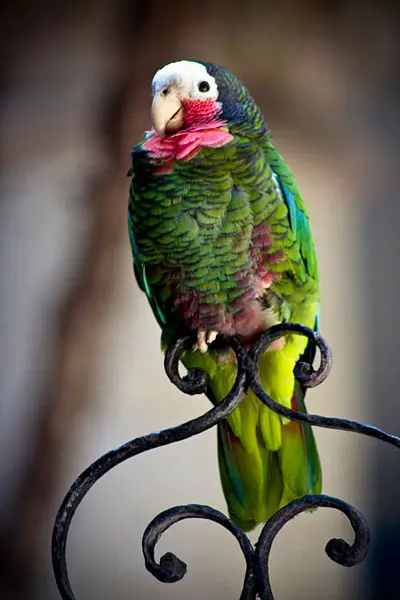
It wasn’t until the 1970s when Cuban amazons’ captive breeding did greatly increase. Prior to the 1970s, breeding these exotic birds in captivity used to be quite unsuccessful.
And while nowadays Cuban parrots’ availability has significantly increased, it remains one of the most high-priced parrots one can keep as a pet.
You can acquire a Cuban amazon through a reputable breeder. However, do note that the difficulty of captive breeding, as well as the near-threatened status of Cuban parrots, makes them quite rarely available for sale.
Interesting Facts
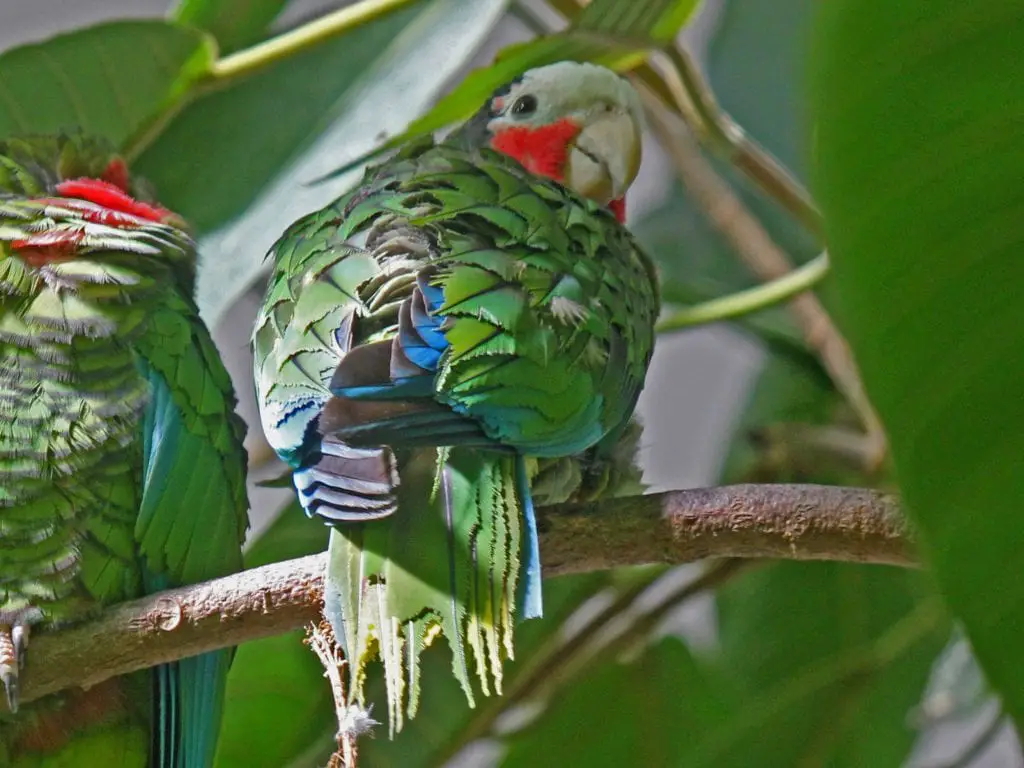
1. Wild Cuban Amazons have been observed in Puerto Rico. However, no reproduction has been recorded. The Cuban parrots spotted in Puerto Rico are believed to be the result of escaped pets.
2. Cuban amazons play an important role within their ecosystem. Because of their large home ranges and the fact that these parrots can fly over significantly longer distances, they are regarded as important seed dispersers, making it possible for many local plants to keep thriving.
3. While most subspecies of the Cuban amazon, including the members of the nominate race, are known to build their nests in hollow tree cavities, there is an exception. The Abaco Bahama amazon population is known to nest in limestone cavities located in the ground, instead of up in the hollows of the trees.
4. The eggs of Cuban amazons hatch asynchronously. Young chicks are born within 12-72 hours apart.
5. The chicks are to perch at the very entrance at the nest when they are ready to fledge. Their parents will then call to them, coaxing their young from the nest.
6. Cuban amazons’’ calls are generally described as a wide array of harsh screeches. Also, they are well-known for their shrill, metallic shrieks. Some of their calls are said to closely resemble a braying donkey. Other calls are described as a double “yaaart” sound, which is quite long and scolding.
How to Care for the Cuban Amazon
1. Housing
As a rule of thumb, Cuban Amazons are very active birds.
They require a cage that is as large as the potential owner’s budget allows. Provide an aviary or a suspended cage measuring at least 9.8ft. (3 meters) in length.
Also, provide a retreat to guard your pet against fear responses and/or insecurity.
Make sure to opt for durable cage construction. It is best if you can provide an outdoor cage, as well, where the Cuban Amazon can enjoy fresh air and access to natural sunlight.
Make use of a wide variety of toys, namely food-finder toys, fir branches, non-destructible toys, destructible toys, preening toys, vegetable-tanned leather toys, push-and-pull toys, foot toys, as well as hanging perch toys of different size and texture.
2. Diet
Suitable fruits as part of a healthy captive diet include but are not limited to banana, cactus fruits, apples, mangoes, pomegranate, pears, and oranges.
Suitable vegetables include celery, green peas, cooked beans and pulses, green leaves, fresh corn, and carrots, among others.
Fruits and veggies should be served daily, making up for about 30% of the diet.
The rest of the diet should consist of limited mixed seed and spray millet.
Offer sunflower and safflower seeds only as occasional treats, since Amazons are prone to obesity. When using a well-formulated commercial diet, there is no need to supply additional vitamins.
Complete kibble is crucial.
3. Personality
Cuban amazons are very intelligent and especially inquisitive birds.
Also, they have excellent talking abilities and are very active by nature.
However, mature males have a tendency to become aggressive. Their aggressiveness may not be exhibited towards the owner but will almost inevitably be exhibited towards their cage mates.
To reduce mate aggression, owners need to utilize durable cage construction. Nonetheless, cage management is crucial.
One way to help females escape the ravages of the often aggressive breeding males is to clip the males’ wings but do treat this as a last resort. It is arguable whether wing clipping is at all humane.
When in breeding condition, Cuban amazons are known for becoming extremely noisy. Therefore, they may not be well-suited to those who live in apartment settings.
4. Possible Health Issues
As a rule of thumb, Cuban Amazons are relatively healthy birds.
However, they are more or less susceptible to health and behavioral issues/conditions, such as mate aggression, poor eating habits, feather picking, infections (fungal, respiratory, viral), fatty tumors, Chlamydiosis, obesity.
FAQs
What Do Cuban Amazons Eat?
In the wild, Cuban amazons eat a variety of seeds and fruits obtained from tropical trees and shrubs native to their home range, as well as tender, young shoots, leaf buds, and cones. In captivity, they require a healthy, balanced, varied diet consisting of limited mix seed/high-quality pelleted diet and daily servings of non-toxic, bird-safe fruits, and veggies.
Where Do Cuban Amazons Live?
Cuban Amazons, just like their name suggests, live in the main island of Cuba, as well as on several other Caribbean islands. They thrive at elevations of up to 3280ft.
How Long Do Cuban Parrots Live?
Cuban parrots are renowned for their longevity. Similarly to other Amazona species, they can live for over 50 years of age.
Do Cuban Amazons Make Good Pets?
Cuban Amazons are not commonly kept as pets due to the difficulty of captive breeding (despite the increased success of breeding Cuban parrots in captivity), and nonetheless, due to their status as near-threatened species. Being highly intelligent and active, Cuban amazons can make great pets for the dedicated and experienced bird care enthusiast.
Are Cuban Amazon Parrots Endangered with Extinction?
Yes, Cuban Amazon parrots are endangered with extinction. They are listed as Near Threatened on the IUCN Red List, and the population trend is estimated as decreasing, with severe habitat loss, trapping for the exotic wild bird trade, and the consequences of climate change being the major survival threats.

